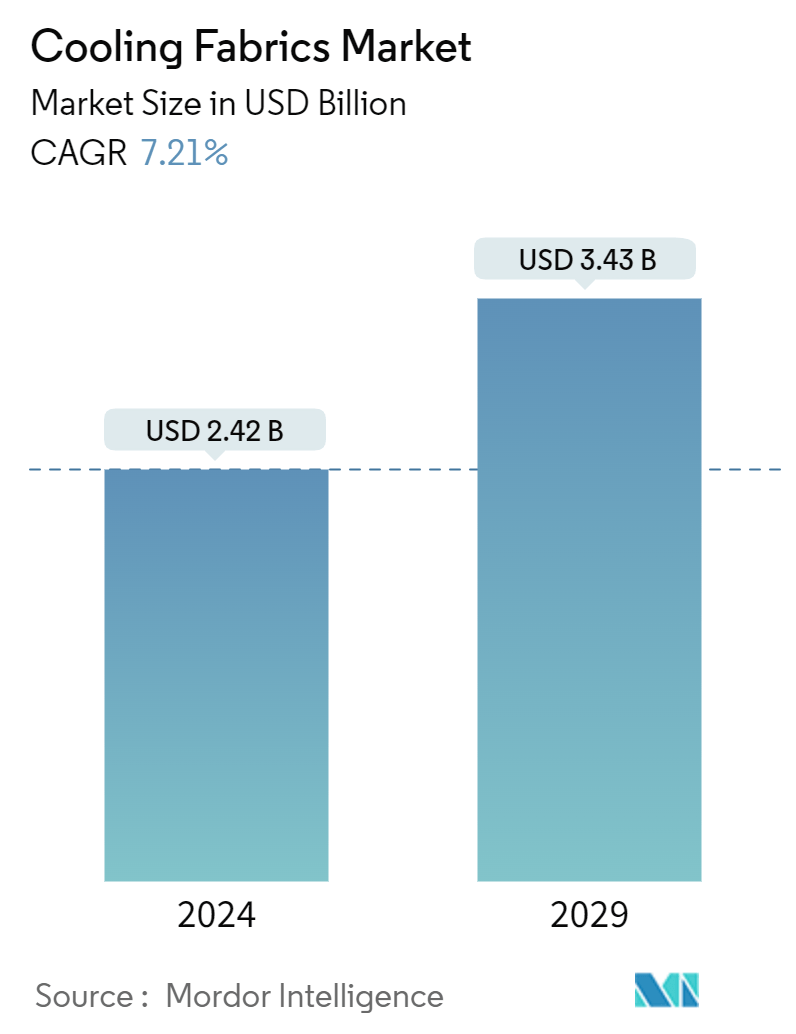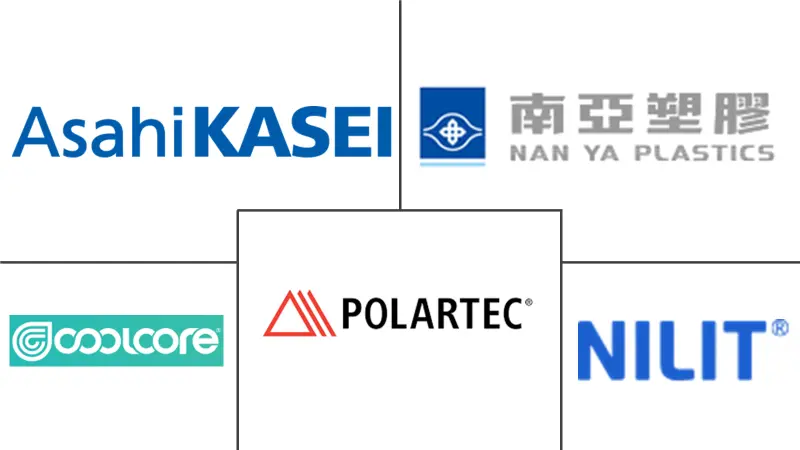Market Size of Cooling Fabrics Industry

| Study Period | 2019 - 2029 |
| Market Size (2024) | USD 2.42 Billion |
| Market Size (2029) | USD 3.43 Billion |
| CAGR (2024 - 2029) | 7.21 % |
| Fastest Growing Market | Asia Pacific |
| Largest Market | North America |
| Market Concentration | Medium |
Major Players
*Disclaimer: Major Players sorted in no particular order |
Cooling Fabrics Market Analysis
The Cooling Fabrics Market size is estimated at USD 2.42 billion in 2024, and is expected to reach USD 3.43 billion by 2029, growing at a CAGR of 7.21% during the forecast period (2024-2029).
The cooling fabrics market is gaining significant traction as the need for temperature-regulating materials across various industries, particularly in sportswear, continues to grow. Cooling fabrics are innovative textiles designed to dissipate heat, providing a cooling effect that is highly sought after in applications such as performance wear, protective clothing, and more. The market is driven by innovations in both natural and synthetic fabrics, with advancements in textile technology propelling the industry forward.
The market is characterized by its extensive application across different segments, notably sportswear, where the moisture-wicking and temperature-regulating properties of fabrics are crucial. The development of smart textiles and phase change materials has further enhanced the functionality of cooling fabrics, enabling them to adapt to changing environmental conditions and improve user comfort. As these technologies evolve, the cooling fabrics market is poised for significant growth.
Rising Demand for Sportswear Fuels Market Growth
- Enhanced Performance Needs: The increasing global focus on fitness and outdoor activities has led to a surge in demand for sportswear made from cooling textiles. Consumers now seek apparel that provides comfort while enhancing performance by maintaining optimal body temperature during intense physical activities. Innovations in moisture-wicking fabrics have become a key focus, catering to athletes and fitness enthusiasts who require high-performance sportswear.
- Integration of Smart Textiles: The incorporation of smart textiles into sportswear is a significant market driver. These textiles often include sensors and other technologies that offer functionalities like real-time monitoring of body temperature and moisture levels. This technological integration not only enhances the functionality of sportswear but also creates opportunities for manufacturers to offer premium products tailored to the specific needs of professional athletes.
- Broadening Applications: Cooling fabrics are expanding beyond traditional sportswear into sectors such as healthcare and military applications. In these fields, the ability to regulate temperature and provide comfort under extreme conditions is critical, broadening the market's scope and driving demand for advanced cooling textiles.
Challenges in Cost and Production
- High Production Costs: The production of advanced cooling fabrics involves specialized fibers and technologies that can drive up manufacturing costs. These high costs make cooling fabrics more expensive than conventional textiles, posing a barrier to wider adoption, especially in price-sensitive markets. Efforts to reduce production costs without compromising performance are crucial for expanding market reach.
- Market Penetration Issues: The higher price point of cooling fabrics impacts their penetration into mass markets. While there is significant demand in niche markets like professional sportswear and military applications, capturing the broader consumer market remains challenging due to price sensitivity. Manufacturers are focusing on innovations that reduce costs, aiming to make cooling fabrics more accessible to a wider audience.
- Supply Chain Complexities: The production of cooling fabrics involves a complex supply chain, including the sourcing of advanced materials and specialized manufacturing processes. Disruptions in this chain can lead to delays and increased costs, challenging market growth. Companies are working to streamline supply chains and establish partnerships to ensure a steady supply of materials and components necessary for producing cooling fabrics.
Cooling Fabrics Industry Segmentation
Cooling fabrics are breathable fabric, which allows air to circulate and flow through the fabric. Cooling fabrics absorb heat from the body to help keep the temperature cool. These fabrics are widely used by healthcare professionals, athletes, and others. These fabrics draw moisture away from the body while sweating to help in lowering body temperature and prevent dehydration.
The cooling fabrics market is segmented by type, fabric type, application, and geography. By type, the market is segmented into natural and synthetic. By fabric type, the market is segmented into woven, non-woven, and knitted. By application, the market is segmented into sportswear, protective wear, apparel, and others (medical, etc.). The report also covers the market size and forecasts for the market in 15 countries across the globe. For each segment, the market sizing and forecasts have been done on the basis of value (USD).
| Type | |
| Natural | |
| Synthetic |
| Fabric Type | |
| Woven | |
| Non-woven | |
| Knitted |
| Application | |
| Sportswear | |
| Protective Wear | |
| Apparels | |
| Others (Medical, etc.) |
| Geography | |||||||
| |||||||
| |||||||
| |||||||
| |||||||
|
Cooling Fabrics Market Size Summary
The cooling fabrics market is experiencing a robust recovery and growth trajectory following the disruptions caused by the COVID-19 pandemic. Initially, the pandemic led to significant setbacks, including halted production and restricted mobility of textile goods, which delayed production and caused economic disruptions. However, the market has since rebounded, reaching pre-pandemic levels and is poised for steady growth. The sportswear application segment emerges as the largest consumer of cooling fabrics, driven by the demand for thermoregulation and comfort in athletic apparel. Despite the higher cost of cooling fabrics compared to traditional options posing a challenge, the expanding use in defense, healthcare, and medical sectors presents new opportunities for market expansion.
North America stands as the dominant region in the global cooling fabrics market, with the United States and Canada leading in consumption. The presence of major manufacturing companies and a focus on performance-oriented sports products have bolstered the region's market position. The United States, a competitive manufacturer of textiles, continues to see growth in textile imports, further supporting market demand. The ongoing technological advancements and increasing interest in sports and personal fitness are expected to further drive market growth. Key players in the market, such as Asahi Kasei Corporation, Coolcore, and Polartec, are actively contributing to the market's development through innovations and sustainability initiatives.
Cooling Fabrics Market Size - Table of Contents
-
1. MARKET DYNAMICS
-
1.1 Drivers
-
1.1.1 Growing Demand for Synthetic Fabrics
-
1.1.2 Increasing Demand for Sportwear Fabrics
-
1.1.3 Other Drivers
-
-
1.2 Restraints
-
1.2.1 High Cost of Cooling Fabrics
-
1.2.2 Other Restraints
-
-
1.3 Industry Value Chain Analysis
-
1.4 Porter's Five Forces Analysis
-
1.4.1 Bargaining Power of Suppliers
-
1.4.2 Bargaining Power of Buyers
-
1.4.3 Threat of New Entrants
-
1.4.4 Threat of Substitute Products and Services
-
1.4.5 Degree of Competition
-
-
-
2. MARKET SEGMENTATION (Market Size in Value)
-
2.1 Type
-
2.1.1 Natural
-
2.1.2 Synthetic
-
-
2.2 Fabric Type
-
2.2.1 Woven
-
2.2.2 Non-woven
-
2.2.3 Knitted
-
-
2.3 Application
-
2.3.1 Sportswear
-
2.3.2 Protective Wear
-
2.3.3 Apparels
-
2.3.4 Others (Medical, etc.)
-
-
2.4 Geography
-
2.4.1 Asia-Pacific
-
2.4.1.1 China
-
2.4.1.2 India
-
2.4.1.3 Japan
-
2.4.1.4 South Korea
-
2.4.1.5 Rest of Asia-Pacific
-
-
2.4.2 North America
-
2.4.2.1 United States
-
2.4.2.2 Canada
-
2.4.2.3 Mexico
-
-
2.4.3 Europe
-
2.4.3.1 Germany
-
2.4.3.2 United Kingdom
-
2.4.3.3 Italy
-
2.4.3.4 France
-
2.4.3.5 Rest of Europe
-
-
2.4.4 South America
-
2.4.4.1 Brazil
-
2.4.4.2 Argentina
-
2.4.4.3 Rest of South America
-
-
2.4.5 Middle East and Africa
-
2.4.5.1 Saudi Arabia
-
2.4.5.2 South Africa
-
2.4.5.3 Rest of Middle East and Africa
-
-
-
Cooling Fabrics Market Size FAQs
How big is the Cooling Fabrics Market?
The Cooling Fabrics Market size is expected to reach USD 2.42 billion in 2024 and grow at a CAGR of 7.21% to reach USD 3.43 billion by 2029.
What is the current Cooling Fabrics Market size?
In 2024, the Cooling Fabrics Market size is expected to reach USD 2.42 billion.

